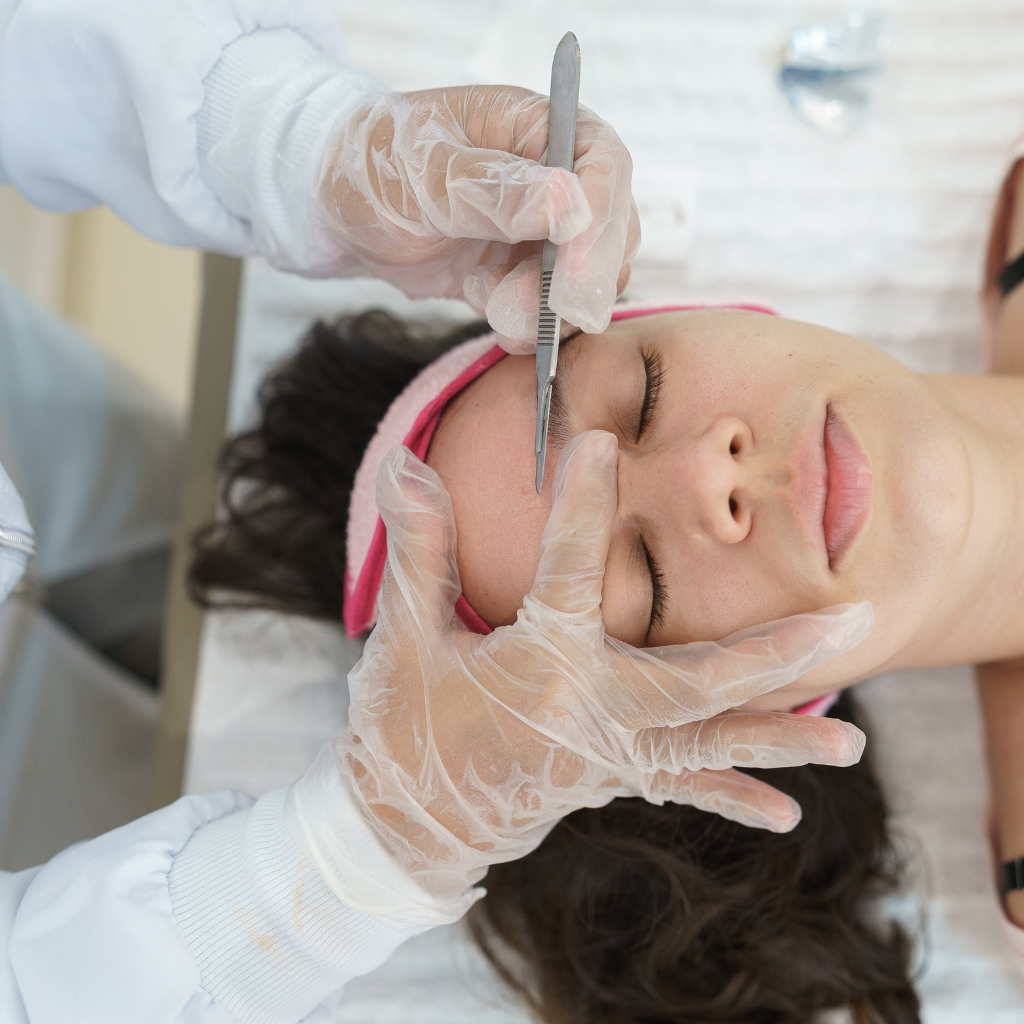How Often Can You Get Dermaplaning for Smoother Skin and Safe Results?
- Home
- Skin Rejuvenation
- how often can you do dermaplaning

Dermaplaning is generally advised once every 3 to 4 weeks to maintain optimal skin smoothness while ensuring the skin has time to heal safely between sessions. This frequency allows for effective exfoliation and removal of peach fuzz while accommodating various skin types. For sensitive skin, intervals may extend to every 6-8 weeks, whereas oily skin may require a more frequent 3-week cycle. Results are enhanced when paired with a suitable skincare regimen. To uncover the personalised nuances of dermaplaning, continuing the exploration of this topic is beneficial.
Key Takeaways
- Most individuals can undergo dermaplaning every 3 to 4 weeks for optimal smoothness and safety.
- Oily skin benefits from dermaplaning every 3 weeks for effective exfoliation.
- Sensitive skin types should consider dermaplaning every 6-8 weeks to reduce irritation.
- Consult a certified skincare professional for a personalised dermaplaning schedule.
- Regular dermaplaning sessions maintain effective exfoliation and smooth skin appearance.
How Often Can You Get Dermaplaning for Smoother Skin Results?
The frequency of dermaplaning treatments should be tailored to individual skin types, with many dermatologists recommending a schedule of every three to four weeks for ideal results.
Individuals with sensitive skin may require a longer interval between sessions to minimise potential irritation and guarantee recovery.
It is essential to consult with a certified skincare professional to determine candidacy and develop a personalised treatment plan.
What’s the ideal dermaplaning schedule for your unique skin type?
How frequently should one consider dermaplaning to achieve perfect results for their specific skin type? The ideal frequency for dermaplaning depends largely on individual skin type and needs. For most individuals, professional dermaplaning every 3 to 4 weeks guarantees effective exfoliation of dead skin cells and removal of peach fuzz. However, those with sensitive skin may benefit from less frequent treatments to prevent irritation. Establishing a dermaplaning schedule tailored to one’s skin type can enhance both safety and efficacy. Dermatological evidence emphasises personalised approaches to maximise benefits.
| Skin Type | Frequency | Notes |
|---|---|---|
| Normal | Every 3-4 weeks | Standard maintenance |
| Oily | Every 3 weeks | More frequent exfoliation |
| Dry | Every 4-6 weeks | Avoid excessive dryness |
| Sensitive | Every 6-8 weeks | Minimize irritation risk |
Are you a good candidate for this treatment every month?
Determining candidacy for monthly dermaplaning requires an understanding of individual skin characteristics and overall health.
To ascertain if one is a good candidate for this treatment, every month, it is essential to examine your skin type and existing skin concerns. Individuals with sensitive skin may need to determine how often they can undergo regular dermaplaning without irritation.
For those seeking the best results, dermatologists recommend a tailored dermaplaning approach based on professional assessment. People with resilient skin types may benefit from dermaplaning every four weeks, while others might require extended intervals.
Effective at-home dermaplaning can complement professional treatments, provided it is done with caution. Consulting with a skincare specialist guarantees an evidence-based regimen tailored to individual needs.
How Often Should You Dermaplane Based on Skin Type?
The frequency of dermaplaning should be adjusted based on individual skin type to optimise skincare outcomes and guarantee safety.
For sensitive skin, it is generally recommended to space treatments every four to six weeks to prevent irritation while still benefiting from exfoliation.
Prior to undergoing dermaplaning, individuals should consult with a skincare professional to assess their unique skin needs and any contraindications.
How do regular treatments help improve your skincare routine?
When considering the integration of dermaplaning into a skincare routine, one must assess its frequency based on individual skin type to optimise results.
Regular dermaplaning treatments serve as an effective exfoliating treatment to remove dead skin cells, which can accumulate and dull the complexion. This precise facial treatment reveals smooth skin, enhancing the absorption and efficacy of subsequent skincare products.
Evidence suggests that consistent exfoliation through dermaplaning can lead to more radiant skin by promoting cell turnover.
As part of a structured skincare regimen, dermaplaning can improve both the texture and appearance of the skin.
How often is a dermaplane facial safe for sensitive skin types?
For individuals with sensitive skin, the frequency of dermaplaning must be approached with caution to ascertain safety and efficacy.
Sensitive skin types are more prone to irritation; therefore, it is advisable to limit dermaplaning sessions to once every 4 to 6 weeks. This interval allows ample time for the skin condition to stabilise and regenerate between treatments.
Dermaplane facials serve as a mild exfoliating procedure that eliminates dead skin cells and fine peach fuzz, leaving the complexion smooth. However, overuse can exacerbate sensitivity.
Incorporating gentle exfoliants in the skincare regimen between sessions can help maintain results without overburdening the skin. Adjustments to the dermaplaning frequency should be made based on individual skin responses to ascertain the best outcomes.

What should you know before you get dermaplaning done?
Before opting for dermaplaning, individuals should consider their skin type to determine the appropriate frequency of treatment.
Dermaplaning employs a sterile scalpel to exfoliate the outermost layer of dead skin cells and vellus hair, contributing to a smoother skin appearance. Those with oily or acne-prone skin may benefit from dermaplaning every two to four weeks, as frequent exfoliation can help regulate sebum production.
Conversely, individuals with sensitive or dry skin should dermaplane less often, approximately every four to six weeks, to prevent irritation.
It is essential to integrate dermaplaning into a thorough skincare regimen that includes gentle exfoliants and sun protection. Consulting with a dermatologist guarantees safe results tailored to individual skin needs, as over-exfoliation may compromise the skin barrier.
How Does Dermaplaning Support Effective Skincare and Exfoliation?
Dermaplaning and microdermabrasion are popular exfoliation techniques that efficiently remove dead skin cells and fine vellus hair, enhancing the absorption and effectiveness of skincare products.
For safe and ideal results, at-home dermaplaning should be performed every two to four weeks, depending on individual skin type and sensitivity.
To maintain the benefits post-treatment, it is essential to incorporate a gentle skincare routine, including hydrating serums and sunscreen, to protect the newly exposed skin.
How often can you do at-home dermaplaning for exfoliation?
How frequently should one engage in at-home dermaplaning for optimum exfoliation?
Clinically, it is recommended that at-home dermaplaning be conducted once every one to two weeks. This frequency allows the removal of dead skin cells and peach fuzz, facilitating smoother skin and enhancing the effectiveness of skincare products.
When done properly, dermaplaning can lead to a more radiant complexion by refining the surface of your skin.
- A dermaplaning tool should be used with caution to prevent irritation.
- Consistent exfoliation supports the natural cell turnover process.
- How often dermaplaning can be done depends on individual skin type and sensitivity.
Adhering to this schedule guarantees optimum results and minimises potential risks associated with over-exfoliating.
What makes effective at-home dermaplaning safe and smooth?
Maintaining an appropriate dermaplaning schedule enhances the safety and efficacy of this at-home skincare practice. Dermaplaning is a non-invasive technique that effectively removes fine facial hair and exfoliates the skin, resulting in a smoother complexion.
To guarantee safe and effective outcomes, individuals should tailor their dermaplaning frequency based on their specific skin type. This personalised approach helps minimise irritation and maximise results.
For the best hair removal and reduction of fine lines, utilising a sterile blade is vital. Additionally, gentle strokes should be employed to avoid damaging the skin’s surface.
Clinical evidence suggests that adhering to these guidelines can improve skin texture and enhance the absorption of skincare products, making at-home dermaplaning a beneficial addition to skincare regimens.
How do you maintain results after dermaplane treatment?
To effectively maintain the results achieved from dermaplaning, a thorough post-treatment skincare routine is essential.
Tailoring this routine based on your skin type can help sustain smoother skin and minimise pore appearance. Frequent dermaplaning necessitates adherence to certain guidelines to prevent redness and irritation.
Limiting exposure to the sun is vital, as UV rays can intensify skin sensitivity post-treatment.
- Use a broad-spectrum sunscreen: Protects against harmful UV rays, vital after a dermaplane treatment.
- Incorporate gentle moisturisers: Hydrates and soothes skin, reducing the appearance of fine lines.
- Avoid harsh exfoliants: Refrain from using chemical peels immediately post-treatment to prevent exacerbating redness.
These steps not only maintain results but also enhance the overall efficacy of regular dermaplaning sessions.
What Are the Benefits of Dermaplaning for Smooth Skin?
Dermaplaning is an effective method for the removal of dead skin cells, providing a smoother skin surface and enhancing the absorption of skincare products. In fact, dermaplaning can help improve overall skin tone and texture, especially when incorporated into a regular skincare routine.
Post-procedure, it is recommended to follow with hydrating and soothing skincare regimens to get the best results and maintain skin health. For most individuals, dermaplaning is recommended every three to four weeks, though this may vary depending on skin type and sensitivity.
With regular sessions, the effects of dermaplaning can be sustained, typically lasting several weeks. Combining dermaplaning with other treatments like chemical peels or serums may further enhance outcomes and support long-term skin rejuvenation.
How does dermaplaning help remove dead skin cells effectively?
While exfoliation plays a crucial role in skin care, dermaplaning offers a precise method to remove dead skin cells effectively. This technique involves gently shaving your face with a sterile blade, targeting the entire face to achieve smoother skin.
The benefits of dermaplaning include enhanced exfoliation, which promotes cell turnover and reveals a more radiant complexion. Conducted professionally in a spa setting, dermaplaning helps to remove the outermost layer of dead skin cells, unclogging pores and allowing skincare products to penetrate deeper.
- Precise Exfoliation: Dermaplaning targets fine vellus hair and dead skin cells for a polished look.
- Enhanced Product Absorption: Removing debris on the skin surface allows for better skincare efficacy.
- Immediate Results: The procedure provides noticeable smoothness and brightness after a single session.

What skincare steps should follow a dermaplane facial session?
After undergoing a dermaplane facial session, it is crucial to adhere to a specific skincare regimen to maximise the benefits and protect the newly exposed skin.
The post-treatment skincare routine should begin with the use of a gentle cleanser to remove any residual impurities without irritating the skin.
Moisturise promptly to provide necessary hydration and support the skin’s barrier function. Incorporate serums rich in antioxidants to promote healing and liveliness.
Sunscreen is a critical component; application of broad-spectrum SPF is imperative to avoid sun exposure and prevent UV damage.
Refrain from additional exfoliation for several days post-treatment to minimise irritation.
Following these steps guarantees dermaplaning results in smoother skin while maintaining safety and efficacy.
How long do the benefits of dermaplaning last with frequent use?
The efficacy of a post-dermaplaning skincare routine directly influences the longevity of its benefits.
With frequent use, dermaplaning offers smoother skin by effectively targeting fine lines and wrinkles. Clinical observations suggest that results can last up to four weeks, contingent upon the recommended frequency of treatment, typically every three to four weeks. This timeframe allows the skin to regenerate safely without exacerbating conditions like acne or rosacea.
To maximise the benefits, consider:
- Hydration: Adequate moisturisation enhances skin smoothness and prolongs dermaplaning effects.
- Sun Protection: Regular application of SPF is essential to prevent UV damage post-treatment.
- Gentle Exfoliation: Integrating mild exfoliants maintains clear, radiant skin between sessions.
Adhering to these guidelines guarantees safe results while optimising dermaplaning’s efficacy.
When Do You Need Dermaplaning Again After One Treatment?
The necessity for repeated dermaplaning sessions can vary based on individual skin conditions and concerns. While some individuals benefit from treatments several times a year, others may require more frequent sessions to maintain results.
Clinical indicators that suggest more regular treatments include the rapid return of vellus hair or the reemergence of dull, uneven skin texture. However, determining the optimal frequency for dermaplaning should involve a professional assessment, taking into account factors such as skin sensitivity, lifestyle, and desired outcomes.
In certain cases—such as active acne, rosacea, or hypersensitive skin—it may be advisable to avoid dermaplaning altogether to prevent irritation or adverse reactions.
What signs suggest you need dermaplaning more frequently?
How can individuals determine the appropriate frequency for dermaplaning to maintain ideal skin smoothness?
Regular assessment of skin texture and appearance is essential. If one notices a dull complexion or accumulation of dead skin cells, it may indicate a need for more frequent dermaplaning. This treatment aids in exfoliation, removing peach fuzz and unclogging pores, which promotes glowing skin.
Signs that suggest an increased frequency of dermaplaning include:
- Dull complexion: Lack of radiance may indicate excessive buildup of dead skin cells.
- Clogged pores: Frequent congestion can suggest the necessity for regular exfoliation.
- Uneven skin texture: Persistent rough patches might require addressing through more consistent dermaplaning.
These indicators help optimise the frequency of dermaplaning for achieving smoother, revitalised skin.
How do you know if frequent dermaplaning is right for you?
When considering the necessity of frequent dermaplaning, individuals should evaluate their skin’s response to the initial treatment and the duration of its benefits.
The frequency of dermaplaning largely depends on skin type and sensitivity. Those with resilient skin types may tolerate bi-weekly sessions, enhancing exfoliation and removing facial hair effectively. Conversely, sensitive skin may require longer intervals to guarantee safe results.
Professional advice is vital in determining an appropriate schedule, as experts can assess how dermaplaning integrates into one’s skincare routine.
Benefits such as smoother texture and improved product absorption should be weighed against potential irritation. Tailoring frequency to individual needs guarantees ideal outcomes while maintaining skin health.
Monitoring the skin’s reaction post-treatment is essential for adjusting future dermaplaning sessions.
Conclusion
To sum up, dermaplaning is a safe and effective exfoliation technique that can be tailored to individual skin types and needs. For best results, sessions are typically recommended every four to six weeks, allowing the skin to regenerate naturally. This procedure not only enhances smoothness and radiance but also improves the efficacy of skincare products. By understanding skin type and adhering to a personalised schedule, individuals can achieve and maintain a vibrant, healthy complexion through regular dermaplaning.

Highly skilled cosmetologist at Tune Clinical Aesthetics, specializing in advanced skin and hair treatments.





